Watercolor art is the most common type of painting. Long ago, the method was used for easy drawing of patterns, creating sketches. Watercolor was considered the most practical paint - easy to mix colors, easy to apply to any surface.
Paintings could contain rough lines, blurry renderings, and in the 19th century, artists began using watercolors as a blank (they painted what they saw on the streets), which were then completed in workshops with oils and inks. This is how sketching was born - turning sketches into full-fledged paintings, - accessible to study for both beginners and professionals.
What is sketching
At first glance, it may seem that this method of drawing is crude, similar to a child's drawing, which has no boundaries, beauty or completeness.
Sketching is a method of quickly drawing objects and objects of observation that may require further refinement. They are necessary to outline the outline of the sketch, “so as not to forget” what to write about next.
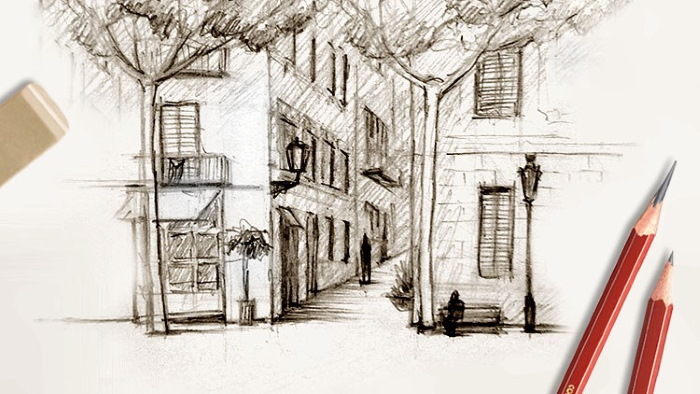
When people start painting with watercolors, they tend to be obsessed with mixing paints to get the perfect colors. At the same time, they want to do everything quickly because it's a sketch. Watercolors require deliberate strokes. They should look watery on the page.
How wet the paper is, how much water is in the brush, how much new paint material must interact with what has already been laid out on the working surface: if all these conditions are not met, the watercolor painting will look ridiculous and damp, which is what a new kind of painting technique means - sketching.
Why and who needs the quick drawing technique
If earlier sketches were called virtuoso drawings, today they are images of people, fashion trends, cities, interior items. This also includes images of cars.
The main criteria are the speed of sketching, stylization and confidence in execution.
Sketching involves several features:
- You need to quickly depict a thought on a piece of paper to convey it to your interlocutor. This is the case in interior or exterior design.
- Describe in detail (in the form of sketches) the image of the future fashion show - what models will be relevant for the season or next year.
- Sketches that reflect the essence of the author's idea. This includes illustrations of hand-made creations, photographic accuracy.
Sketching is most often associated with markers such as Copic, Stylefile marker, ZIG and TOUCH. In fact, the palette of shades is more diverse, but initially the classic manual presentation of the image in 2-3 colors is important.
For this purpose the following can be used:
- mascara;
- watercolor;
- watercolor pencils;
- coal;
- regular and colored ink;
- pastel.
In the modern world of technology, even graphic drawings "on the fly" are used. This is necessary for designers, artists and web designers who are engaged in the creation of fashion trends and the styling of Internet projects.
Genres of Watercolor Sketching
Watercolor sketching for beginners represents a certain boundary in drawing that is difficult for a beginner to cross.
Experienced artists treat this type of art direction as a creative niche, which also has several genres:
- Dessert (food sketching) – this is a typical image of dishes for creating layouts of future menus or blanks for photo scenes.
- Travel sketching - sketches of cities and streets. This genre has been known since the time of Bhagvanji Sonagra. The paintings clearly show road maps, transport and outlines of people.
- Botanical genre is dedicated to the skill of depicting nature on a lined sheet of paper - most often, the perspective markings are used from a distant object to a close one in the foreground. It is easier to draw close and distant objects on such paper.
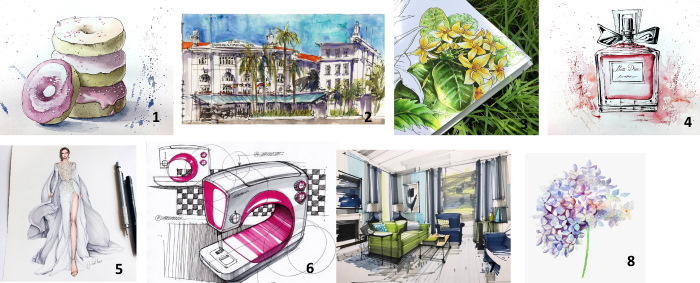
- Subject sketching are related to the work of design art, when there is a need to depict individual art objects. For example, the genre is appropriate for presenting a scheme for creating posters or banners. The paper is visually divided into several parts, where independent ideas are depicted.
- Fashion sketching - a schematic representation of outfits. Previously and now, such sketches were made by craftsmen, seamstresses, clothing designers for clarity or approval of sketches.
- Industrial sketching involves creating previews of objects. For example, you need to create a template for the future design of a smartphone. The design engineer draws a sketch and makes changes.
- Interior sketching is entirely dedicated to the creation of room designs and commercial premises.
- Floral illustration can depict a "portrait" of the future design of the exterior, landscape. This genre is suitable for creating blanks when developing decorations for banquet halls. On the sheet you need to arrange all the decoration items, which are then placed in the real interior.
There are also such trends as urban illustrations. They differ from travel art, showing more detailed projects of houses, not entire streets. Recently, it has become popular to paint portraits of people in this genre.
Sketching techniques
There are several techniques that help create simple and complex sketches. For a basic set, it is enough to use lines and dots, geometric shapes and strokes.
To complicate compositions, the following techniques are used:
- Any painting must be done in perspective. This applies not only to interiors, but also to clothing sketches. It is much more difficult to imagine a model's outfit in motion.
- The shape of an object is determined by lighting and shadows. If you express subject sketching without shadows, the drawing will look like a child's drawing, where there are only circles, squares and watercolor stains. With shadows, it gains volume.
- The completeness of the picture will be achieved through shading. Children love to paint over the empty spaces, and adults like to complement them with short lines of varying widths. Small ones will indicate corners in the interior, and wide ones will indicate supporting beams or convex objects.
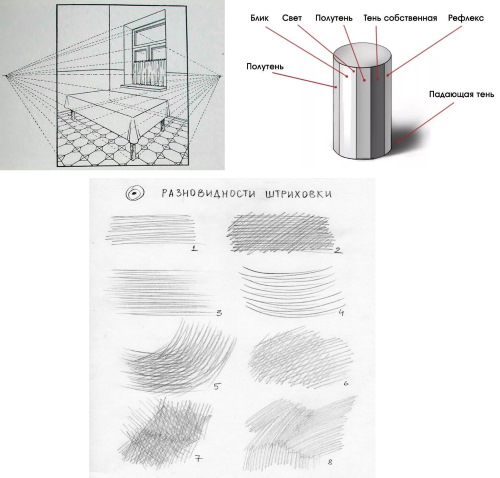
In order to select the "right" techniques for each genre, it is necessary to distinguish the features of the drawing. In the simplest drawings, something else is sometimes missing to feel the picture is complete. This is the opinion of the artist Lin Ching Che. He introduced the concept of the "wet on wet" drawing technique (English watercolor).
The idea is to apply watercolour paint to a pre-moistened sheet of paper. As a result, the paintings acquire an ideal look for creating rainy landscapes. The technique is relevant when creating city sketches.
How to learn watercolor sketching
In academic painting, a sketch is a drawing of a future painting. In modern times, this technique can be used for preparatory work, as well as a quick depiction of objects.
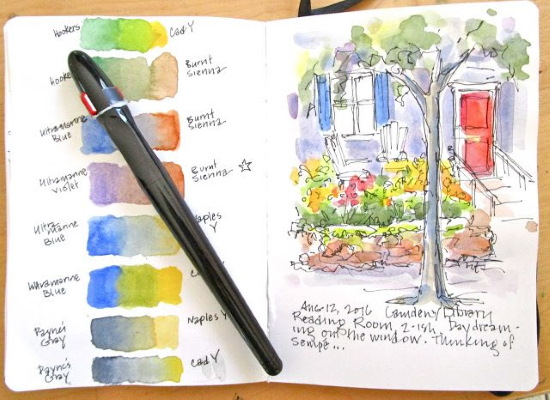
To learn sketching without delving into the process of studying painting, it is enough to know the basic rules:
| Sketch plan | First, you need to imagine what kind of object you want to depict. Let it be an object of regular shape. Big cities are easier to draw than "a still life with shadows and half-shadows in the perspective of an angular view." |
| Genre | It is necessary to choose a genre - portrait and painting are considered too difficult for beginner artists. It is better to give preference to interior graphics in 2D-image (top or side view). |
| Perspective | Interior or clothing designers can already imagine what an object looks like in motion. It will be much easier to fit interior items, furniture, and decorative elements inside the drawing. You need to imagine that the observer sees all 4 cardinal directions, and depict them in the drawing as receding lines to the center of the sheet. You will get something in the form of a tunnel. |
| Markers or watercolors | Markers are used in those genres where it is necessary to convey the clarity of boundaries. For example, in interior design. If we talk about watercolor, it is ideal for creating volumetric illustrations - cities, streets, crowds of people. The paint has a large coverage, which means that a lot of streets, cars, people can be depicted with 1-2 strokes. |
| Strokes | Hatching in sketching replaces shadows and half-shadows in painting. The thicker the stroke, the more you want to draw thin lines next to it. On the sheet, it looks like a dark area and one that is slightly illuminated (thick and thin lines). |
Tips for Beginners
Watercolor sketching for beginner designers is best mastered from the preparatory stages. First of all, you need to draw for 15-20 minutes a day to get used to the technique.
This skill helps improve the quality of sketches in a short time. You can also learn sketching on your own by buying a sketchbook, which contains basic drawings for developing skills.
Tools and materials
Watercolor sketches are not only made with paints and pencils. You can use markers, felt-tip pens and other drawing tools.
The basic set includes:
- brushes of different sizes;
- watercolor pots;
- slate pencils;
- eraser;
- a small container for water;
- towels;
- block of thick watercolor paper.
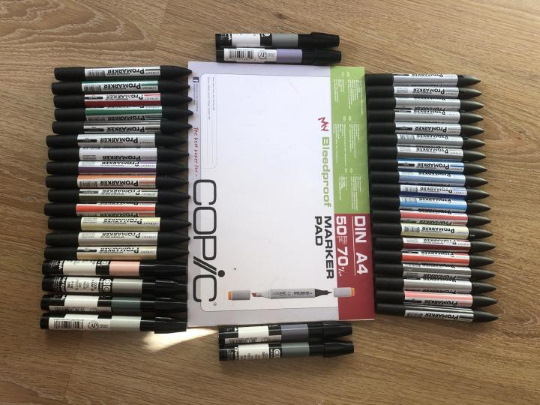
Simple pencils can be replaced with Copic analogues. It is better to exclude charcoal and pastel, as they are used to draw texture, and this process is not always necessary in sketching.
To create a specific interior design, you should choose standard color schemes of paints:
- brown color "Natural Oak, Touch, BR 91";
- neutral grey colour "Stylefile NG No.2";
- dark gray "Chartpak No. 8";
- mint with a hint of blue "Mint Blue, Touch, B143".
You can use a marker or a liner for sketching as tools. A white gel pen is suitable for creating accents and highlights. The sheet of paper should be A6 size (10*15 cm). On small sheets, drawing small details will not be difficult. On a large area, the accent should be detailed smaller, more clearly.
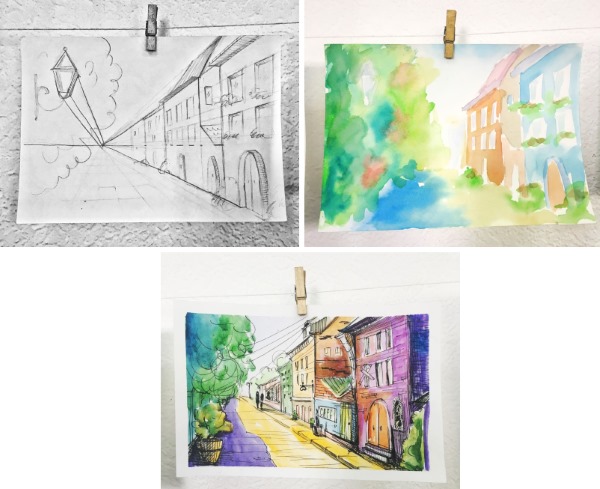
After creating the blank, you need to draw the details:
- You should place accents with a black marker in those places where there are the most "muted" distant areas. As a rule, this is the background - it is barely visible through the veil of colors.
- Next, you need to add some accents to the drawing. You can do this with a colored marker. You can shade the background, which is in the drawing in the near perspective (closer than the black objects), with pastel colors.
- The "milky" clouds should be done with strokes from the middle of the sheet to the upper edge, gradually reducing the pressure on the marker. This way, vertical asymmetry is achieved, penumbra is created. It is easier to do this with watercolors - the paint runs out at the end of the stroke, leaving a less bright color.
- The penultimate stage is drawing the graphics. It is necessary to catch the moment when the sun illuminates individual sections of skyscrapers, if white color is used for glare.
To detail objects, you need to use the wide tips of the marker (its edge). These are the most visible, convex parts of buildings and their outlines. After that, in sketching, you need to pay attention to dark colors. In this technique, they are superimposed on the hatching - this is how volumetric effects are obtained.
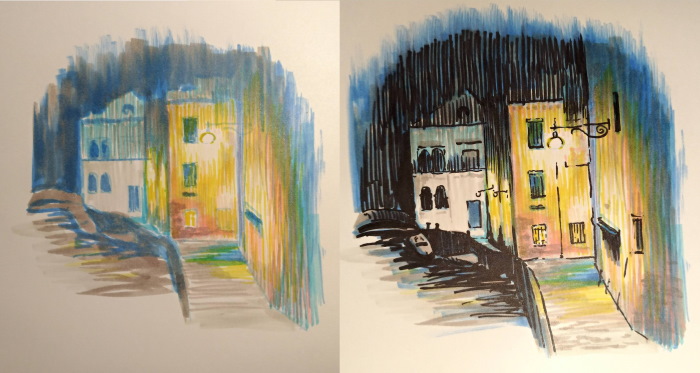
Black marker always shows through when applied over bright paint. In this case, black and white can be used to highlight the painted areas to freshen up the drawing.
Watercolor sketching can be done using different techniques depending on the genre and the chosen plan. In some areas (landscape, still life) it is impossible to do without paints. And in this section of "wet" painting there are several features that beginner artists need to know - these are the types of techniques with which you can create a variety of interpretations of drawings.
Glazing technique
If you need to get deep tints during the drawing process, the glazing or glaze technique is used. Glazing involves applying one color over another. This allows you to get rich shades of the base color.
The technique is performed in 3 variations:
- Wet on wet – watercolor is applied to the base color, which has not yet had time to dry. As a result, a new shade of the base is obtained due to the translucent texture of the top layer.
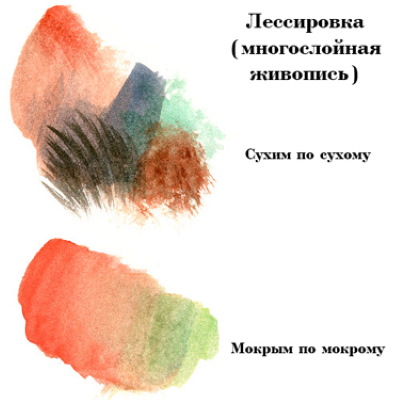
- Dry on dry - with dried brushes, strokes are applied so that the base color is almost covered by the new color. This method is used in industrial design, where the upper thin layer changes the palette of the previous one.
- Wet on dry – a complex glazing technique where the top layer creates an optical illusion of mixing colors. In reality, they overlap, partially covering the pigments without mixing them completely.
The technique is also used in applying several layers on an opaque base in a dry version. When working with watercolors, underpainting (for oil) is not required. The same rule applies to acrylics.
Important! The technique is not applicable everywhere - it gives out the brightness of the colors, allowing them to stand out. Excessive gloss is difficult to remove, as is creating matte depth. For example, when painting the sky, glazing is not required.
English Watercolor Technique
Watercolor techniques are divided into several conventional subtypes, which are grouped according to criteria:
- Special effects – this group includes the use of salt, crumpled paper, cling film, tea leaves, and splashing techniques.
- In terms of color palette, the following trends are used: “monochrome (grisaille) watercolor”, “dichrome” and multicolor.
- According to the purity of technical execution, there are directions: “pure technique”, mixed, using whitewash, pencils, pastels, ink and other combinations.
- According to the methods of painting, there are reserves (4 techniques), strokes, washing, filling, stretching, and paint extraction.
- Depending on the degree of brush moisture, painting is divided into dry (wrung out), wet and semi-dry.
- There are 2 techniques based on the number of layers of paint application: multi-layer (glazing) and single-layer.
- Depending on the degree of paper moisture, a combination technique is distinguished: drawing on fragmentarily moistened paper, “on dry” and “on wet”.
The English painting technique refers to the type of application of brushstrokes "on wet".
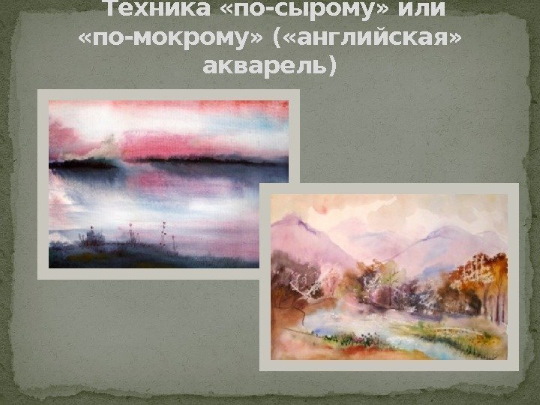
In the process it looks like this:
- The sheet must be moistened with water in advance using a brush.
- You can work after the paper stops "shining". The canvas remains damp.
- The paint should be applied using the wet-on-wet technique.
The result is an ideal match between the degree of humidity of the brush and the water-soaked sheet.
Reservation
A true watercolorist has a sense of purity when painting. Sketching also involves the use of this technique. The idea is to keep the white parts of the sheet white and apply the pigment with a brush.
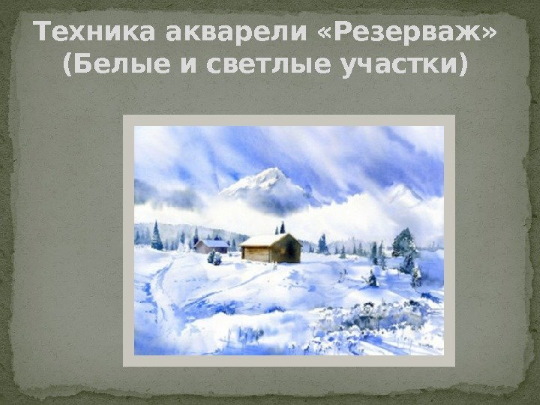
White paint cannot be used, and artists often use several techniques to maintain the boundaries of white:
- Walkaround - a complex but "clean" version of the reservation. You can use "wet" techniques, but with a reserve where the paint can spread.
- Mechanical action on the dried edge of the paint – the method involves scratching the sheet with a sharp object to reveal the white backing.
- Masking reservation – use of products at any stage of painting creation for subsequent bleaching (removal). Splashes, spot accents, and highlights of other colors may fall on areas covered with the solution. All this is removed with a solvent, and the contrast boundary with the white sheet is maintained perfectly.
In the reserve technique, you can create complex technical paintings from a sketch and use various writing methods.
Technique of working on a wet sheet with subsequent finishing on a dry sheet
This technique includes 2 classic methods - "on wet" and "on dry". The point is that according to the degree of moistening of the brush, the direction is chosen "dry", and according to the moisture content of the sheet - wet.
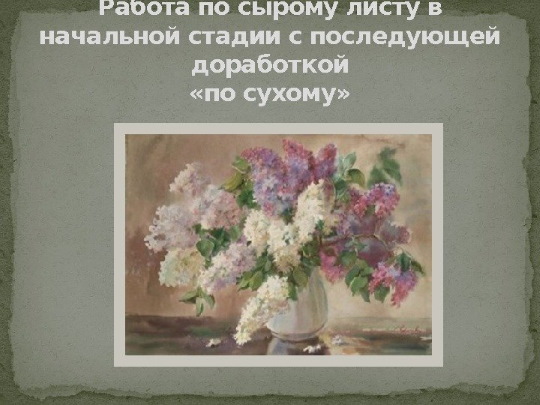
Mixed or combined watercolor technique in sketching involves the use of two techniques at once:
- The background or individual fragments should be wetted with water. The first layer is also applied to a wet surface.
- After the paper and the first layer of paint have dried, you need to draw the main elements of the foreground - paint is applied in several layers.
The result is blurred lines mixed with contrasting colors. At this point, diffusion occurs, when the sheet expands in places where it is moistened, and the paint penetrates inside it. You can see how "bird feathers" are formed in those fibers of the sheet that are not completely wetted with water.
A La Prima
The technique is performed at a fast pace – paint is applied to a damp (wet) sheet in one layer.
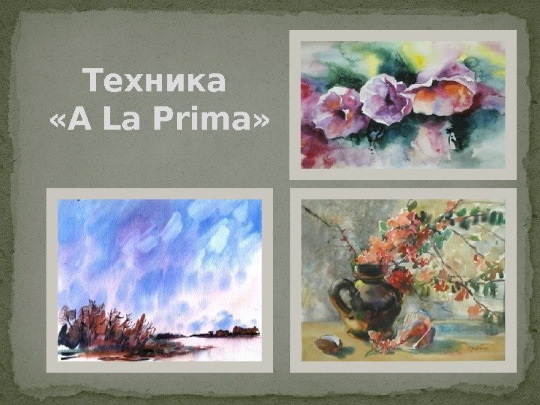
During the session, you can get quite beautiful effects of stains, iridescence and flow of colors. "La Prima" means that the artist "for the first time" paints the sheet, after which he immediately dries it.
Watercolor sketching for beginners in the "A la Prima" technique allows you to keep the drawing fresh without the need to draw details. This drawing method is best suited for sketching.
Dry technique of the Italian school
To create a sketch drawing using this technique, you must first apply paint in 1 or 2 layers onto a dry sheet of paper, then wait for it to dry:
- Single-layer watercolor "on dry" involves applying paint in 1 layer. Touches should be precise with a thick layer of paint. If the color rendering is poor, you can add an additional shade to the wet layer.
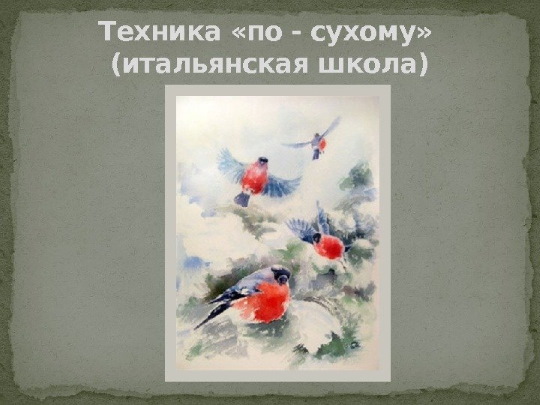
- Multilayered watercolor "on dry" involves the use of 2 different shades, which are applied while the paint of the 1st layer is not dry. Unlike the previous technique, in this direction bright accents are achieved, overlapping the 1st layer.
To avoid streaks and "dirty" colors, it is better to paint with a bright range of colors. This method is not suitable for landscapes (dark background).
Washing
This technique allows you to quickly create several single-color layers. To do this, the artist takes 1 part of paint and dilutes it in 6-8 parts of water. The result is a translucent liquid with added pigment. It can be used to create a background, apply several additional layers.
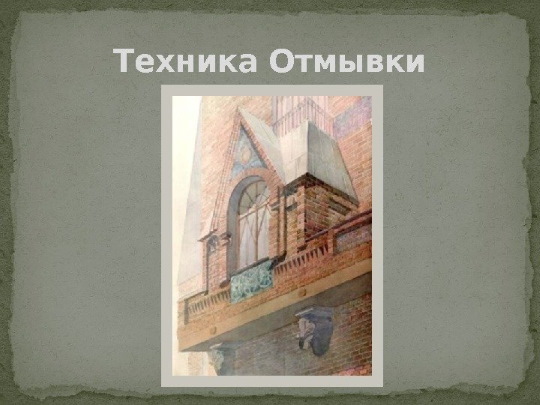
Washing involves applying several layers of one color (blue, light blue). The method is suitable for architectural designers who need to achieve an ideal background (transparent), which will serve as a base for the drawing.
Use of salt
Watercolor sketching for beginners will be interesting in the technique of creating special effects. Artists use such an ingredient as salt in painting. Its crystals are applied to a wet layer of watercolor to absorb excess moisture.
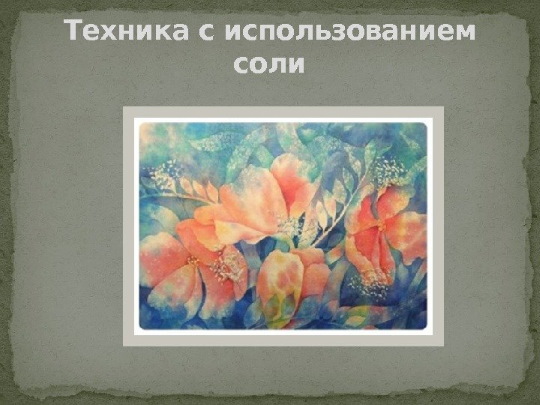
As a result, the path of water to the salt crystal leaves behind a unique streak.This technique helps to create a moving haze in the sky or a cloud that hovers over the city.
Using crumpled paper
Watercolor on pre-crumpled paper behaves very interestingly, unlike oils and pastels. The paint has a tendency to accumulate in the places where the sheet bends, creating additional volume.

The main thing is to decide in advance on the theme of the drawing and the technique for folding the sheet.
Use of other materials
A good tool for creating an additional effect is film. It can be applied to the finished drawing on the wet surface of the paints. When the watercolor dries, the film can be removed.
The result is an interesting effect - the paint accumulates in those places where the film forms a joint, rising above the sheet. The effect of layering is achieved in glazing.
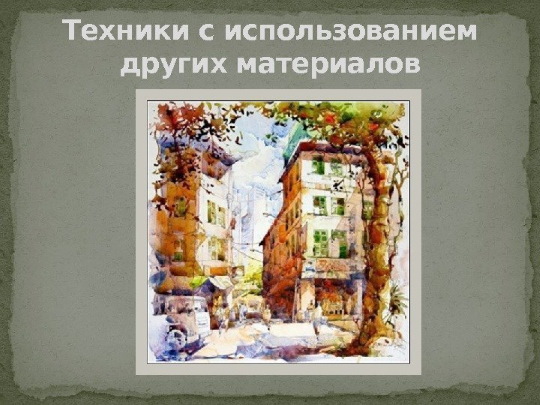
Watercolor sketching can be learned in just a few lessons. Gradually, you should master different drawing techniques. In addition, you can use markers, watercolor pencils and other items to create the desired effect. Experimenting with paints is a great opportunity for beginner artists to find a suitable mechanism for applying them.
Video about watercolor sketching
Watercolor sketching for beginners - drawing cherries:

Interesting about the beautiful. Thank you. And "watercolor pots;" is that a typo?